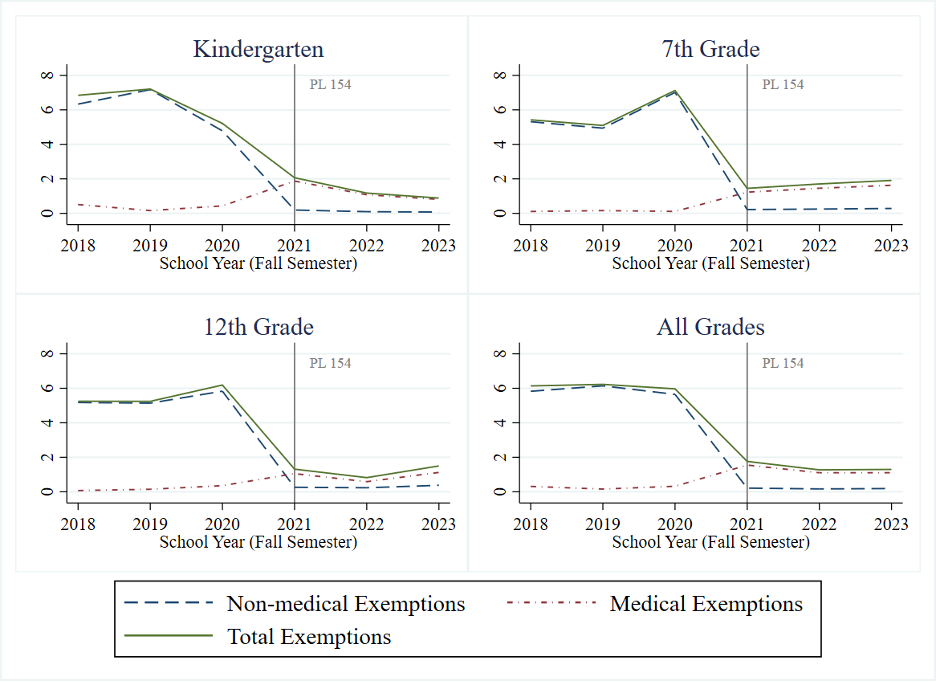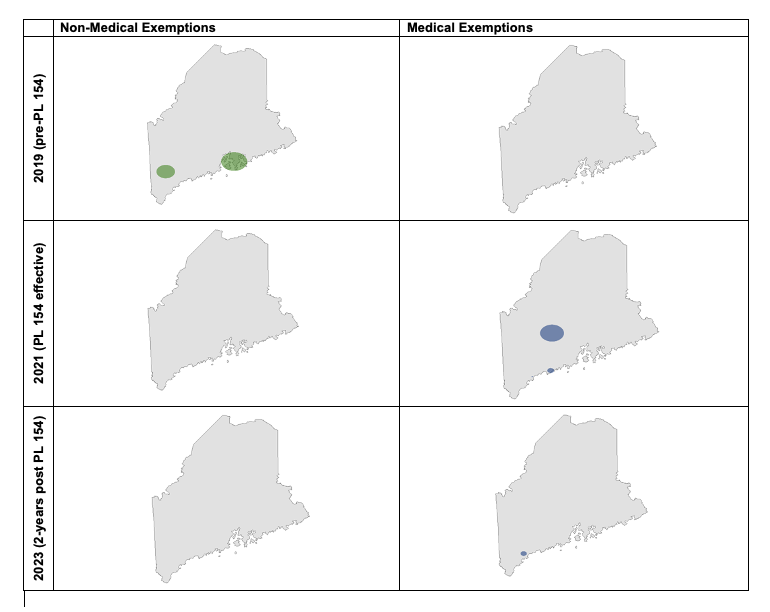Public Health & Prevention 4
Session: Public Health & Prevention 4
801 - Impact of Maine Public Law 154 on Rates and Spatial Clustering of Medical Vaccine Exemptions, 2018-2023
Monday, April 28, 2025
7:00am - 9:15am HST
Publication Number: 801.5426
Laura J. Faherty, Maine Medical Center/RAND, Cape Elizabeth, ME, United States; Ashley Gromis, RAND, Santa Monica, CA, United States

Laura J. Faherty, lfaherty@rand.org (she/her/hers)
Senior Physician Policy Researcher/Attending Physician
RAND/Maine Medical Center
Cape Elizabeth, Maine, United States
Presenting Author(s)
Background: Maine Public Law (PL) 154, which passed in 2020 and went into effect in 2021, eliminated non-medical exemptions (NMEs) from school immunization requirements. Our prior work in California found that State Bill 277, which also eliminated NMEs, was associated with spatial clustering of medical exemptions (MEs) in the same locations with previously high NME rates, suggesting a substitution effect.
Objective: To examine the percentage of Maine students with vaccine exemptions (medical, non-medical, and total) each year from 2018-2023 and determine if PL 154 was associated with spatial clustering of MEs.
Design/Methods: We used annual data for 2018-19 to 2023-24 from the Maine Center for Disease Control on number of students entering kindergarten, 7th grade, and 12th grade with each type of vaccine exemption. We matched these data by school name and county to data from the National Center for Education Statistics and Maine’s Department of Education to obtain school location. We geocoded school addresses to obtain latitude and longitude coordinates using the ESRI 2017 StreetMap (Redlands, CA) address locators in ArcMap 10.8.2. We excluded 27 school-grade-year observations with missing coordinates due to address changes that could not be geocoded. Kulldorff spatial scan statistics were used to detect spatial clustering in MEs in Maine kindergartens before and after PL 154.
Results: Our sample consisted of 703 schools, representing 2,537 school-grade-years. In 2020, the year PL 154 was passed, about 6% of Maine students had an NME, while < 0.5% had an ME (Figure 1). In 2021, the year PL 154 went into effect, MEs across all 3 grades increased four-fold to nearly 2%, primarily driven by kindergarten students. This percentage declined slightly in 2022 and 2023. Two clusters of kindergartens with significantly higher likelihood of NMEs that were present in 2019 disappeared, as expected, after PL 154 became effective. Two new clusters of kindergartens with significantly higher likelihood of MEs appeared in 2021 (Figure 2).
Conclusion(s): PL 154’s elimination of NMEs was associated with an overall decrease in percentage of students in Maine with vaccine exemptions. MEs, previously rare, increased over 4-fold in 2021. Unlike California, spatial analysis of new clusters of kindergartens with increased likelihood of children with exemptions did not suggest a substitution effect in the same locations. Policies to promote vaccination in school-aged children should be accompanied by strong implementation guidance and oversight of ME approvals to ensure the validity of MEs.
Figure 1. Percentage of Maine students in kindergarten, 7th grade, 12 grade, and all grades with vaccine exemptions, by type, before and after passage of PL 154 (2018-2023)

Figure 2: Spatial clustering of Maine kindergartens with statistically significantly increased risk of non-medical (green shaded areas) and medical (blue shaded areas) vaccine exemptions relative to the statewide population average in selected years before and after PL 154 went into effecteas) vaccine exemptions relative to the statewide population average in selected years before and after the passage of PL 154


